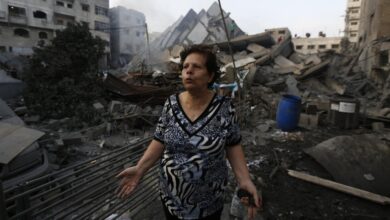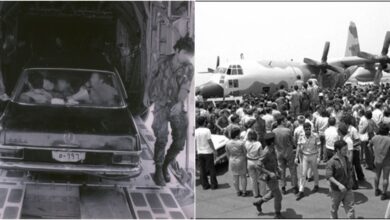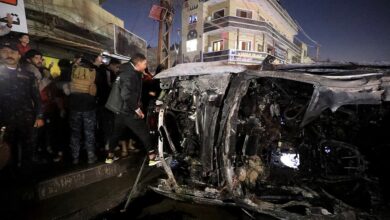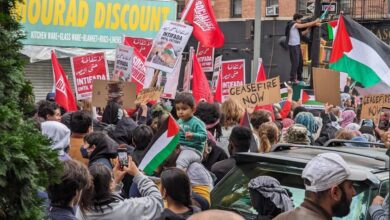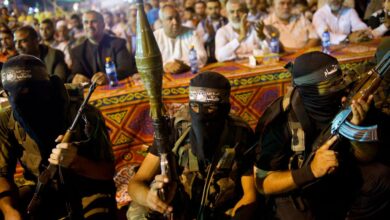
Israel Founding The Palestinian Conflict
Israel founding palestinian conflict is a deeply complex and often tragic story. From competing claims to land and historical narratives, the roots of this conflict run deep. This exploration delves into the historical context, the pivotal wars, and the ongoing negotiations, ultimately examining the multifaceted nature of the dispute and its impact on both Israelis and Palestinians. We’ll analyze the role of international actors and examine the current situation, aiming to provide a balanced and nuanced perspective on this enduring conflict.
The conflict’s origins lie in the tumultuous aftermath of World War II, where the creation of a Jewish state in Palestine ignited a spark that continues to burn. Understanding the competing historical claims, the geopolitical landscape, and the human cost is crucial to grasping the gravity of this enduring issue.
Historical Context
The conflict between Israelis and Palestinians is rooted in deeply intertwined historical narratives and competing claims to the land of Palestine. Understanding the events leading up to the 1948 Arab-Israeli War requires examining the complex interplay of political, religious, and social factors. This examination necessitates careful consideration of the differing perspectives of both sides, recognizing the subjective nature of historical interpretation.
Chronological Account of Events Leading to the 1948 War
The region’s history is marked by successive waves of migration, settlement, and political change. From the Ottoman Empire’s rule to the British Mandate, the landscape was shaped by shifting power dynamics. The Zionist movement, advocating for a Jewish state in Palestine, gained momentum in the early 20th century, leading to increasing tensions with the Palestinian Arab population. The Balfour Declaration of 1917, promising a “national home for the Jewish people” in Palestine, became a crucial point of contention.
These developments created a complex environment ripe for conflict.
Competing Claims and Perspectives on Land Ownership and Historical Presence
The Jewish and Palestinian perspectives on historical presence and land ownership are fundamentally different. Zionists viewed the land as a historical connection to the ancient Jewish kingdom, arguing for a right to self-determination and a homeland. Palestinians, meanwhile, saw the land as their ancestral homeland, and the presence of Jewish immigration as a threat to their existing way of life and their historical claim to the land.
The Zionist narrative emphasized a biblical connection, while the Palestinian perspective focused on centuries of continuous Arab presence and cultural ties.
Role of International Actors and Organizations
The League of Nations, later the United Nations, played a pivotal role in the unfolding events. The 1947 UN Partition Plan, intended to resolve the conflict, divided Palestine into separate Jewish and Arab states. However, this plan failed to account for the complex political and social realities of the region and ultimately failed to prevent conflict. The plan’s acceptance by the Jewish community and rejection by the Palestinian community further exacerbated tensions.
The involvement of major powers, such as the United Kingdom, France, and the United States, also significantly influenced the situation. Their policies and actions during this period had a profound impact on the course of events.
Impact of Key Figures
Several key figures significantly shaped the trajectory of the conflict. Chaim Weizmann, a prominent Zionist leader, played a crucial role in advocating for a Jewish state. David Ben-Gurion, Israel’s first prime minister, was instrumental in the establishment of the state. On the Palestinian side, leaders like Hajj Amin al-Husseini and the Palestinian leadership in general, articulated Palestinian resistance to the increasing Jewish immigration and the partition plan.
These individuals’ actions and decisions directly contributed to the escalating tensions and the eventual outbreak of the 1948 war.
Impact of Key Events: A Chronological Table
| Year | Event | Israeli Perspective | Palestinian Perspective |
|---|---|---|---|
| 1917 | Balfour Declaration | Recognition of Jewish right to a national home in Palestine. | Violation of Palestinian rights and a threat to their existing presence. |
| 1920s-1930s | Jewish immigration and Palestinian resistance | Increased Jewish settlement as a step toward statehood. | Displacement and dispossession of Palestinian Arabs due to increasing Jewish immigration. |
| 1947 | UN Partition Plan | A just solution to the conflict, dividing the land between two states. | An unjust plan that violated Palestinian rights and historical claims to the land. |
| 1948 | Arab-Israeli War | Establishment of the State of Israel. | Displacement and loss of land. |
The 1948 War and its Aftermath
The year 1948 marked a turning point in the history of the Middle East, a turning point etched in the blood and tears of both Israelis and Palestinians. The newly declared State of Israel, born amidst the ashes of the British Mandate, immediately faced opposition from neighboring Arab states. This conflict, often referred to as the 1948 Arab-Israeli War, had profound and lasting consequences, shaping the political landscape of the region and creating a refugee crisis that continues to resonate today.
The war’s origins lay in the complex interplay of competing national aspirations, unresolved historical grievances, and the absence of a clear and universally accepted resolution to the future of Palestine.The conflict escalated rapidly, fueled by fears and anxieties on both sides. The newly formed Israeli state, seeking to consolidate its hold on the land, was met with resistance from Arab states who felt their interests were not adequately represented.
The war, marked by brutal fighting and strategic maneuvering, saw both sides suffer significant losses and endure immense hardship. The outcome was a profound shift in the demographics of the region, and the consequences of this war would continue to reverberate for generations.
Circumstances Surrounding the 1948 Arab-Israeli War
The British Mandate for Palestine, expiring in 1948, left a vacuum that different groups sought to fill. Jewish communities, seeking a homeland, and Arab Palestinians, hoping to maintain their control over the land, both laid claim to the territory. The UN Partition Plan, intended to divide the land into separate Jewish and Arab states, was a controversial proposal that failed to satisfy the needs of either side.
The Israeli founding undeniably sparked the Palestinian conflict, a deeply rooted and complex issue. While seemingly disparate, the struggles for self-determination and cultural expression, as exemplified by figures like those highlighted in the Harlem Renaissance, find a common thread in the human desire for dignity and recognition. Exploring the rich artistic legacy of abney bey fordjour simmmons harlem renaissance met offers a glimpse into similar battles for cultural identity that, in their own way, mirror the ongoing struggles for a just resolution to the Israeli-Palestinian conflict.
Ultimately, both situations highlight the profound impact of history on the present.
This lack of consensus and the inherent tensions surrounding the division created an atmosphere ripe for conflict. The existence of paramilitary groups on both sides, fueled by nationalistic fervor, further contributed to the escalating violence.
Displacement and Refugee Crises
The 1948 war resulted in a massive displacement of Palestinian populations. Hundreds of thousands were forced to flee their homes, seeking refuge in neighboring Arab countries. The exact figures are disputed, but estimates place the number of Palestinian refugees at hundreds of thousands, many of whom were never able to return to their homes. This forced displacement, coupled with the lack of resources and support in the host countries, created a humanitarian crisis of immense proportions.
The conditions faced by the refugees were often dire, highlighting the devastating impact of the conflict.
Creation of the State of Israel and Arab Nation Reaction
The declaration of the State of Israel on May 14, 1948, was met with immediate opposition from several Arab nations. Egypt, Syria, Lebanon, Jordan, and Iraq, among others, invaded the newly formed state. This invasion was driven by a combination of factors, including the desire to prevent the establishment of Israel and the belief that the UN Partition Plan was unjust.
The Arab nations, though united in their opposition, did not act as a cohesive force, resulting in a fragmented and ultimately unsuccessful military campaign against the new state.
Key Factors Contributing to Escalation of Violence, Israel founding palestinian conflict
The 1948 war was a complex conflict with numerous contributing factors. The UN Partition Plan, while intended to be a solution, ultimately proved divisive and unacceptable to many Arab states and Palestinian groups. The presence of armed militias on both sides fueled the violence, contributing to the rapid escalation of the conflict. Furthermore, the lack of clear communication channels and a willingness to negotiate exacerbated the situation, making a peaceful resolution nearly impossible.
The strong nationalistic sentiments on both sides played a crucial role in shaping the attitudes and actions of the belligerents.
Impact of the 1948 War
| Date | Event | Impact on Israelis | Impact on Palestinians |
|---|---|---|---|
| May 14, 1948 | Declaration of the State of Israel | Establishment of a Jewish state | Displacement and loss of land |
| Throughout 1948 | Fighting and Displacement | Military gains and consolidation of control over some areas | Massive displacement and loss of homes, land, and property |
| 1949 | Armistice Agreements | Formalization of borders | Continued displacement and limited access to former lands |
| Ongoing | Conflict and Negotiation | Ongoing political and security concerns | Ongoing struggle for self-determination and return |
The Six-Day War and the 1973 War
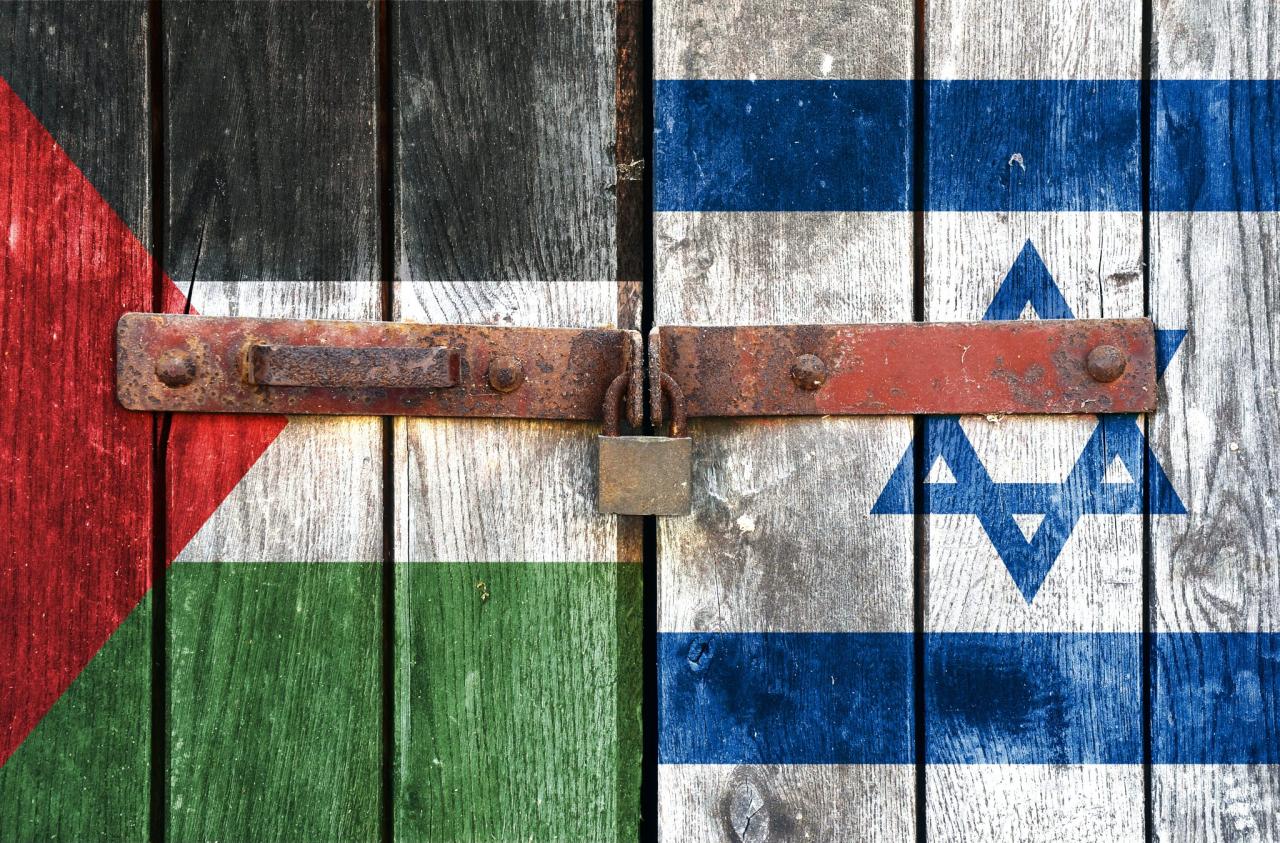
The Israeli-Palestinian conflict, a complex tapestry woven from decades of political, religious, and territorial disputes, experienced significant turning points with the Six-Day War of 1967 and the Yom Kippur War of 1973. These conflicts profoundly reshaped the landscape of the region, altering the balance of power and further complicating the path towards peace. The consequences of these wars continue to reverberate in the region today, impacting both Israeli and Palestinian lives and shaping the political discourse.The Six-Day War, a swift and decisive conflict, fundamentally altered the geopolitical dynamics in the Middle East.
Israel’s victory resulted in significant territorial gains, leading to profound changes in the lives of both Israelis and Palestinians. The 1973 Yom Kippur War, a surprise attack by Egypt and Syria, brought a renewed sense of vulnerability to Israel and exposed the fragility of peace agreements. This war also highlighted the importance of military preparedness and the complex web of international relations influencing the conflict.
Causes and Consequences of the Six-Day War
The Six-Day War erupted in June 1967, triggered by a complex interplay of factors. Israel’s perceived military buildup and perceived threat from Arab states, coupled with Egyptian closure of the Strait of Tiran to Israeli shipping, created a volatile atmosphere. The fear of imminent attack, combined with Arab declarations of intent to destroy Israel, led to the preemptive Israeli strike.
Israel’s victory resulted in significant territorial gains, including the West Bank, Gaza Strip, East Jerusalem, the Golan Heights, and the Sinai Peninsula. These acquisitions profoundly impacted the demographics and political landscape of the region. The war’s consequences included a refugee crisis among Palestinians, heightened tensions between Israelis and Palestinians, and an escalation of the conflict’s intensity. It also drew global attention to the situation and highlighted the urgent need for a resolution.
Territorial Gains and Losses
The Six-Day War led to dramatic territorial shifts. Israel gained control of territories previously held by neighboring Arab states. The loss of these territories by the Arab states had a significant psychological impact, fueling resentment and contributing to the ongoing conflict. The gains included strategic land and valuable resources, significantly impacting the strategic balance of power in the region.
Palestinians, who resided in the occupied territories, experienced profound displacement and loss of property, impacting their lives and livelihoods.
Diplomatic Efforts After the Six-Day War
Following the Six-Day War, numerous diplomatic efforts were undertaken to achieve peace. The United Nations played a pivotal role in mediating negotiations, while various international actors and regional powers attempted to broker agreements. These efforts, however, faced significant obstacles due to the entrenched positions of both sides. The lack of progress in achieving a lasting peace agreement contributed to the continued tension and instability in the region.
Impact of the 1973 Yom Kippur War
The Yom Kippur War, a surprise attack by Egypt and Syria in October 1973, served as a significant turning point in the conflict. The war exposed vulnerabilities in Israel’s military and highlighted the complex interplay of regional and international powers. The Arab victory on the first few days of the war demonstrated that Israel was not invincible and that Arab nations were capable of inflicting significant damage.
The war’s impact also led to renewed diplomatic efforts and a reassessment of the conflict’s dynamics.
Territorial Changes After the Six-Day War
| Territory | Before 1967 | After 1967 | Current Status |
|---|---|---|---|
| West Bank | Part of Jordan | Occupied by Israel | Subject to ongoing Israeli occupation and Palestinian claims. |
| Gaza Strip | Part of Egypt | Occupied by Israel | Subject to ongoing Israeli occupation and Palestinian governance. |
| East Jerusalem | Part of Jordan | Occupied by Israel | Declared part of Israel, but disputed by Palestinians. |
| Golan Heights | Part of Syria | Occupied by Israel | Declared part of Israel, but disputed by Syria. |
| Sinai Peninsula | Part of Egypt | Occupied by Israel | Returned to Egypt in 1982. |
Oslo Accords and Subsequent Negotiations: Israel Founding Palestinian Conflict
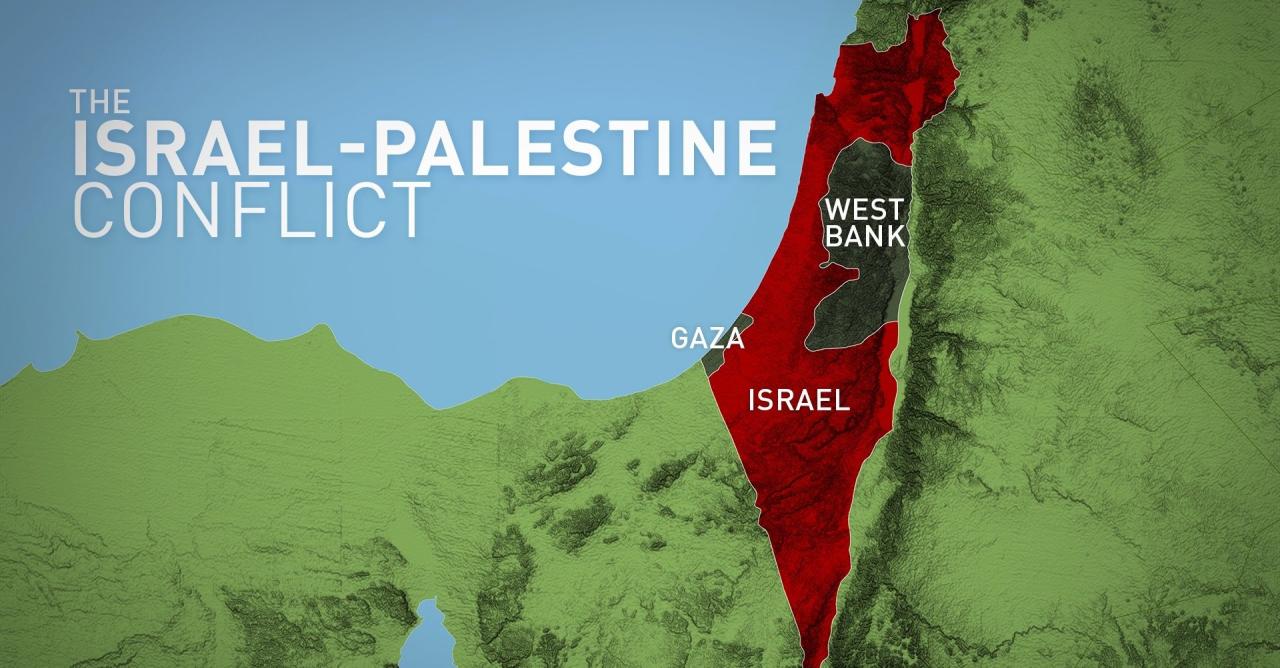
The Israeli-Palestinian conflict, marked by decades of violence and mistrust, entered a new phase with the Oslo Accords. These agreements, forged in the early 1990s, represented a significant attempt to achieve a peaceful resolution through negotiations. However, the path to lasting peace proved fraught with challenges and obstacles, leading to both progress and setbacks. The accords’ legacy continues to shape the landscape of the region, even today.
Key Provisions of the Oslo Accords
The Oslo Accords, signed in 1993 and 1995, were a series of agreements between Israel and the Palestine Liberation Organization (PLO). These agreements aimed to establish a framework for a two-state solution. Crucially, they recognized the PLO as the representative of the Palestinian people and paved the way for Palestinian self-governance in designated areas. Key provisions included the establishment of Palestinian self-rule in the Gaza Strip and the West Bank, and the commitment to negotiate a final status agreement within five years.
These provisions were a significant departure from the previous confrontational approaches.
Negotiations and Agreements Following the Oslo Accords
Following the initial Oslo Accords, several agreements were reached, including the 1995 Interim Agreement on the West Bank and Gaza Strip. These agreements further delineated the roles and responsibilities of both sides, with a particular focus on establishing Palestinian civil administration. The aim was to gradually transfer control of various aspects of governance to Palestinian authorities. The agreements also Artikeld security arrangements between the two parties.
Challenges and Obstacles Encountered During the Peace Process
Despite the initial optimism, the peace process faced numerous obstacles. These included continued violence and attacks by extremist groups on both sides, disputes over borders and settlements, and differing interpretations of the agreements. The failure to address the core issues, such as the status of Jerusalem and Palestinian refugees, also created significant roadblocks. The lack of trust and entrenched positions of both sides were also crucial elements hindering the progress of the negotiations.
Key Events and Figures Involved in These Negotiations
Several key figures played crucial roles in the negotiations. Yitzhak Rabin, the Israeli Prime Minister, and Yasser Arafat, the PLO leader, were instrumental in signing the Oslo Accords, demonstrating a significant shift in political strategy. Shimon Peres, another Israeli leader, and other negotiators on both sides were involved in the subsequent agreements and the challenges that followed. Their efforts, although significant, were not enough to overcome the fundamental obstacles.
Comparison of Peace Proposals
| Proposal | Key Points | Supporters | Objections |
|---|---|---|---|
| Oslo Accords | Recognition of PLO, Palestinian self-governance, phased withdrawal of Israeli forces. | Israel and PLO, international community | Extremist groups, differing interpretations of the agreement. |
| Camp David Summit (2000) | Proposed borders and the status of Jerusalem. | U.S., Israel, and PLO | Disagreement on key issues like borders, settlements, and refugees. |
| Taba Talks (2001) | Further refinement of border negotiations. | Israel and PLO, U.S. | Failure to bridge the gap between the two sides on key issues. |
“The Oslo Accords were a significant step forward in the Israeli-Palestinian peace process, but they ultimately failed to achieve a lasting resolution.”
Palestinian Self-Governance and Settlements
The establishment of Palestinian self-governance, a complex and often contentious process, has been deeply intertwined with the Israeli-Palestinian conflict. The quest for a Palestinian state, alongside Israeli security concerns and the presence of Israeli settlements, continues to shape the landscape of the region. This section will explore the evolution of Palestinian governance structures, examine the Israeli settlement policy, and analyze the varying perspectives on their impact.The Palestinian Authority (PA) represents a significant step toward self-governance, but its effectiveness and scope remain constrained by the ongoing conflict.
The dynamics of the Israeli-Palestinian relationship, influenced by historical grievances and geopolitical factors, have significantly shaped the development and implementation of these governance structures.
The Israeli-Palestinian conflict, a deeply rooted struggle, has undeniably impacted global politics. While the complexities of this historical dispute are immense, it’s fascinating to consider how seemingly unrelated issues, like the fluctuating housing market near NYC, housing market near nyc , can be influenced by similar underlying economic and social pressures. Ultimately, the conflict’s core issues, such as land rights and self-determination, continue to shape the region’s future.
Establishment of Palestinian Self-Governance
The Palestinian Authority (PA) emerged as a result of the Oslo Accords, representing a crucial attempt to establish Palestinian self-governance. These accords, signed in the 1990s, aimed to create a framework for a two-state solution, with the PA assuming administrative control over parts of the Palestinian territories. The establishment of the PA, however, was not without its challenges and has been subject to evolving conditions over the years.
Evolution of Palestinian Governance Structures
The PA’s governance structures have undergone significant development since its inception. Initially, its mandate was limited to certain aspects of civilian life, gradually expanding as negotiations progressed. The PA’s development has been a complex interplay of successes and setbacks, affected by both internal Palestinian politics and external pressures. The degree of control and autonomy exercised by the PA has varied, impacted by the shifting political landscape and security concerns.
Israeli Settlement Policy and its Impact
Israeli settlement policy in the Palestinian territories has been a persistent source of friction. Settlements, established in areas claimed for a future Palestinian state, raise significant concerns about the viability of a two-state solution. The presence of settlements has impacted the physical landscape, the demographics of the region, and the ability of Palestinians to exercise self-determination.
The Israeli-Palestinian conflict is a deeply complex issue with roots stretching back to the founding of the nation-state of Israel. Recent political maneuvering, such as the potential impact of Steve Garvey’s California Senate campaign steve garvey california senate , highlight the ongoing struggles and the need for diplomacy. Ultimately, lasting peace requires understanding and a commitment from all sides to finding common ground, resolving the core issues, and respecting each other’s needs.
Different Perspectives on the Role of Settlements
Perspectives on the role of settlements in the conflict vary considerably. Proponents argue that settlements are a response to security concerns and a matter of Jewish national identity. Critics, however, view them as a significant obstacle to peace, arguing they undermine Palestinian self-determination and the establishment of a contiguous and viable Palestinian state.
Development of Palestinian Authority Institutions
The following table Artikels the development of key Palestinian Authority institutions, highlighting their functions and associated challenges.
| Year | Institution | Function | Challenges |
|---|---|---|---|
| 1994 | Palestinian Authority | Exercise limited self-governance over parts of the Palestinian territories. | Limited control over security, ongoing Israeli presence, and unresolved issues regarding borders. |
| 1996 | Palestinian National Council | Legislative body for the PA. | Facing limitations due to the ongoing conflict. |
| 2000 | Palestinian President | Head of state and government. | Facing political divisions and disputes with Israel. |
| 2006 | Palestinian Legislative Council | Parliamentary body representing the Palestinian people. | Ongoing political tensions and security concerns. |
Current Situation and Future Prospects
The Israeli-Palestinian conflict, a deeply rooted and complex struggle, continues to grip the region. Decades of unresolved issues, escalating tensions, and a lack of trust have created a volatile environment, making a peaceful resolution elusive. The current situation demands a thorough understanding of the obstacles and potential pathways towards a sustainable peace.The ongoing violence and tensions remain a significant challenge.
Sporadic outbreaks of clashes, often sparked by specific events, highlight the fragility of the status quo. These incidents, frequently involving both sides, demonstrate the persistent need for de-escalation and a more comprehensive approach to resolving the underlying issues. The human cost of this conflict is significant, with innocent lives lost and communities impacted.
Ongoing Violence and Tensions
The recent years have seen a resurgence of violence, marked by attacks and counter-attacks. This cycle of retaliatory actions often leads to further escalation, hindering any progress towards a lasting solution. The underlying causes, including grievances over land, settlements, and political rights, continue to fuel the conflict.
Key Obstacles to Achieving Lasting Peace
Several factors contribute to the ongoing difficulties in achieving a lasting peace. These include the lack of trust between both sides, deeply ingrained historical grievances, competing claims to land, and the continuing presence of settlements. The division of Jerusalem and the unresolved refugee issue remain significant stumbling blocks.
Different Approaches to Resolving the Conflict
Various approaches to resolving the conflict exist, each with its own merits and limitations. Diplomatic negotiations, with the involvement of international mediators, remain a critical pathway. The potential for a two-state solution, with mutually agreed borders, has been discussed, but implementation faces significant hurdles. Other proposals focus on achieving a confederation or other forms of shared governance.
Recent Developments in the Peace Process
Recent years have seen limited progress in the peace process. Some initiatives aimed at fostering dialogue and cooperation have been undertaken, but they have yet to yield significant results. The lack of sustained commitment from both sides and the persistent presence of entrenched positions have hampered progress.
Key Issues Dividing Both Sides
| Issue | Israeli Perspective | Palestinian Perspective | Potential Solutions |
|---|---|---|---|
| Land and Borders | Israel has a right to secure borders and defend its citizens. Claims to land are based on historical and religious ties. | Palestinians claim a right to self-determination and a sovereign state within internationally recognized borders. They view settlements as a violation of their land rights. | Negotiating mutually acceptable borders, with clear recognition of security concerns for both sides. International mediation and arbitration can play a crucial role. |
| Settlements | Settlements are considered a natural extension of Israel’s presence in the region, and essential for security. | Settlements are seen as illegal under international law and a major obstacle to a two-state solution, harming Palestinian land ownership and economic development. | Phased withdrawal of settlements, in exchange for security guarantees and other concessions, is a potential solution. International pressure and legal frameworks can be instrumental. |
| Jerusalem | Jerusalem is a united capital of Israel, with historical and religious significance. | Jerusalem is considered the capital of a future Palestinian state, with a claim to specific holy sites and a role in Palestinian identity. | International recognition of Jerusalem’s dual significance, with mutually agreed solutions for the city’s status and administration. |
| Refugees | Addressing the refugee issue requires a regional solution, with a focus on integration rather than repatriation. | Palestinians seek a just solution for refugees, including the right of return or compensation. | International support and assistance in resettlement or compensation programs, alongside regional cooperation. The establishment of a mechanism to address the issue in a comprehensive manner. |
| Security | Israel’s security concerns are paramount and require a robust security framework. | Palestinians seek a security arrangement that respects their sovereignty and self-determination. | Establishment of a framework for security cooperation, with clear mechanisms to prevent violence and ensure mutual security. |
The Role of International Actors
The Israeli-Palestinian conflict has been profoundly shaped by the involvement of international actors. From the United Nations’ early pronouncements to the ongoing efforts of the European Union and the United States, international organizations and nations have played a crucial role in mediating, monitoring, and attempting to resolve this complex dispute. Their actions, however, have often been met with varying degrees of success, highlighting the inherent challenges of navigating this deeply entrenched conflict.
The United Nations’ Role
The United Nations, particularly the Security Council and General Assembly, has been central to the international response to the conflict. The UN has passed numerous resolutions regarding the establishment of a Palestinian state, the return of refugees, and the cessation of hostilities. These resolutions, however, have often been ignored or selectively implemented by the involved parties. The UN Relief and Works Agency for Palestine Refugees in the Near East (UNRWA) has also played a critical role in providing humanitarian aid to Palestinian refugees.
The Israeli-Palestinian conflict, a deeply rooted and complex issue, continues to simmer. Recent political developments, like the Winthrop Poll on Haley and Trump in South Carolina, highlighting shifting political dynamics , offer a fascinating glimpse into the broader political landscape. While seemingly unrelated, these events ultimately underscore the enduring nature of the conflict and its impact on global affairs.
The organization’s sustained efforts in providing vital support to refugee communities demonstrate a consistent, albeit limited, ability to alleviate the human cost of the conflict.
The European Union’s Position
The European Union, through its member states and various institutions, has actively engaged in promoting a two-state solution. The EU has consistently emphasized the need for a negotiated settlement and has frequently called for the cessation of settlement activity. The EU has also supported international efforts to promote reconciliation and has contributed to various peace initiatives. Furthermore, the EU has imposed sanctions on individuals and entities deemed responsible for human rights violations or for hindering the peace process.
The Israeli founding, understandably, has been a deeply complex issue, causing ongoing conflict with Palestinians. Thinking about the competing claims to land is tough, but it’s also interesting to consider how these issues might play out in today’s real estate market. For example, the current housing market near NYC housing market near nyc is experiencing some pretty wild fluctuations, reflecting broader economic trends.
Ultimately, the Israeli-Palestinian conflict remains a significant geopolitical issue with far-reaching consequences.
The United States’ Stance
The United States, a key player in the Middle East, has consistently pursued a variety of approaches to the conflict. The US has been a strong supporter of Israel, often emphasizing its security concerns. Simultaneously, the US has expressed its commitment to a two-state solution, though its approach and actions have often been perceived as biased towards Israel.
The US has also been instrumental in brokering peace agreements, though its influence in achieving a lasting resolution has been questioned.
International Organizations and Initiatives
Numerous international organizations, including the Arab League, have been involved in the Israeli-Palestinian conflict. These organizations have often sought to advocate for Palestinian rights and support reconciliation efforts. Some organizations, like the Quartet, have attempted to coordinate international efforts toward achieving a resolution, while others have focused on specific aspects of the conflict, such as the humanitarian crisis faced by Palestinian refugees.
The role of these initiatives, however, has often been limited by the resistance of the parties to the conflict and the lack of consensus within the international community.
Impact of International Sanctions and Interventions
International sanctions and interventions have had mixed results in addressing the Israeli-Palestinian conflict. Sanctions, while intended to pressure parties to comply with international norms, have often had unintended consequences, including harming civilian populations and failing to significantly alter the conflict dynamics. Interventions, particularly those involving military or diplomatic pressure, have sometimes been seen as intrusive or ineffective. Furthermore, a lack of unified international action has often hindered the effectiveness of these interventions.
Table: Stances of International Organizations
| Organization | Stance | Actions | Impact |
|---|---|---|---|
| United Nations | Advocating for a two-state solution and humanitarian aid | Resolutions, UNRWA operations, peacekeeping missions | Limited impact due to selective implementation and lack of enforcement mechanisms |
| European Union | Supporting a two-state solution and condemning settlement activity | Diplomatic engagement, sanctions, financial aid | Positive impact on diplomatic efforts, but sanctions have limited effect on altering conflict dynamics |
| United States | Supporting Israel’s security and advocating for a two-state solution | Diplomatic mediation, aid to Israel, support for peace initiatives | Varied impact, perceived bias towards Israel has hindered progress towards a balanced resolution |
| Arab League | Advocating for Palestinian rights and supporting reconciliation efforts | Diplomatic efforts, statements condemning Israeli actions | Limited impact due to internal divisions and varying levels of commitment from member states |
Social and Economic Impacts
The Israeli-Palestinian conflict has cast a long shadow over the social and economic landscapes of both societies. Decades of conflict have deeply impacted the daily lives of individuals, fostering a climate of mistrust and hindering the development of a shared future. The consequences extend far beyond the immediate battlefield, permeating the fabric of everyday existence, impacting education, employment, and overall well-being.The conflict has profoundly shaped the social fabric of both Israelis and Palestinians, creating a complex and often adversarial environment.
The resulting social divisions and inequalities have had far-reaching consequences, affecting access to resources, opportunities, and a sense of security. These challenges are further compounded by economic factors, creating a vicious cycle that perpetuates the conflict and impedes progress towards a peaceful resolution.
Impact on Social Fabric
The conflict has fostered deep social divisions, particularly in the West Bank and Gaza Strip. Fear, mistrust, and a lack of security are prevalent, impacting the social fabric and creating a climate of apprehension. Israeli society has also experienced social divisions, though with a different manifestation. The conflict’s long-term effects are particularly apparent in the lack of shared narratives and the limited opportunities for intercultural dialogue and understanding.
Social Inequalities and Challenges
The conflict has exacerbated existing social inequalities and created new ones. Access to education, healthcare, and employment opportunities is often unevenly distributed, with Palestinians in the occupied territories facing significant disadvantages. Discrimination based on ethnicity and political affiliation is widespread, creating an atmosphere of marginalization and exclusion. These inequalities are further exacerbated by the lack of economic opportunities and limited access to resources.
Economic Impact
The conflict has had a devastating impact on economic development in the region. The restrictions and blockades imposed on the Palestinian territories have significantly hindered economic growth and development. The resulting poverty and unemployment rates are alarmingly high. In contrast, while Israel has experienced periods of economic growth, the conflict has diverted resources and attention away from long-term economic development.
Challenges in Achieving Economic Prosperity
The obstacles to economic prosperity are multifaceted. The lack of a comprehensive peace agreement impedes the development of robust trade and investment relations between Israelis and Palestinians. The continuing Israeli settlement expansion and the blockade of Gaza have further complicated economic development. Infrastructure development is hampered by political instability and the absence of a unified regional approach.
Economic Models for Peaceful Coexistence
Several economic models could facilitate peaceful coexistence and prosperity. A model that fosters cross-border trade and investment could stimulate economic growth and create opportunities for mutual benefit. Cooperation in infrastructure development and tourism could further strengthen ties between Israelis and Palestinians. A model emphasizing shared resources and sustainable development would help to foster a sense of shared responsibility and mutual respect.
Examples of Economic Models
Successful economic models for peaceful coexistence in other conflict zones demonstrate the feasibility of such initiatives. The development of special economic zones or joint ventures can stimulate trade and investment, leading to economic growth and creating opportunities for both Israelis and Palestinians. These initiatives require sustained political will, regional cooperation, and the active participation of both sides.
Different Economic Models for Peace
Different economic models can play a significant role in building a lasting peace. Examples include free trade zones, joint ventures in technology and innovation, and collaborative infrastructure projects. Such models not only address the economic needs of both communities but also foster trust and understanding between them. A shared commitment to sustainable development is also crucial, ensuring that economic gains are not at the expense of the environment.
These efforts would demonstrate a commitment to long-term peace and prosperity.
Cultural and Religious Dimensions
The Israeli-Palestinian conflict is deeply intertwined with religious and cultural identities, shaping the narrative and influencing the actions of both sides. These factors are not simply background noise; they are fundamental to the conflict’s complexities and enduring nature. Understanding the role of faith and culture is crucial to comprehending the ongoing struggles and potential pathways toward reconciliation.Religious and cultural beliefs have profoundly influenced the conflict, creating deep-seated sensitivities and intractable positions.
Sacred sites, ancestral ties, and competing interpretations of history contribute significantly to the emotional intensity and historical grievances that fuel the conflict.
Religious Significance of Jerusalem
Jerusalem holds immense religious significance for Judaism, Christianity, and Islam. It is considered a holy city for all three faiths, with historical and religious sites revered by each community. The Old City, with its various holy sites, has been a focal point of contention, with each group claiming historical rights and asserting their right to control and manage these sites.
The differing perspectives on the city’s historical and religious importance create profound emotional ties and have been a major point of contention throughout the conflict.
Cultural Heritage and Identity
The conflict has also impacted cultural heritage and identity, shaping the sense of belonging and community for both Israelis and Palestinians. These aspects are often interwoven with religious beliefs, creating a complex tapestry of cultural and religious identity. The loss of cultural heritage sites, displacement of populations, and restrictions on cultural expression have exacerbated tensions.
Cultural Exchange: A Look at Interactions
Cultural exchange, though often limited by the political climate, does exist between Israelis and Palestinians. There are subtle but important instances of shared cultural heritage.
| Topic | Israeli Aspects | Palestinian Aspects | Shared Aspects |
|---|---|---|---|
| Music | Israeli folk music, contemporary pop, and various genres reflecting the diversity of Israeli society. | Palestinian folk music, particularly from different regions, conveying cultural traditions and stories. | A shared love for music as a form of cultural expression, with traditional instruments and melodies reflecting the shared human experience. |
| Cuisine | Mediterranean and Middle Eastern dishes, often with a focus on fresh ingredients and vibrant flavors, reflecting diverse culinary influences. | Palestinian cuisine, characterized by its unique blend of flavors, spices, and regional variations, emphasizing local ingredients. | The use of shared ingredients and techniques in cooking, showcasing a common culinary heritage. A shared appreciation for the art of preparing meals and celebrating food as a part of social life. |
| Literature | A rich tradition of Israeli literature spanning diverse genres and perspectives, including historical accounts and contemporary narratives. | Palestinian literature, often expressing the experience of displacement and resistance, conveying cultural identity and struggles. | The shared human experience reflected in stories, poetry, and other literary forms. A shared interest in preserving and transmitting stories across generations. |
| Arts | A vibrant Israeli art scene showcasing a wide range of artistic styles, reflecting the diverse artistic perspectives of the country. | Palestinian art forms, reflecting the experiences of the Palestinian people, showcasing unique artistic expressions and traditions. | A shared interest in the arts, with a focus on creativity, aesthetic expression, and the ability of art to reflect and shape our experiences. |
Final Review
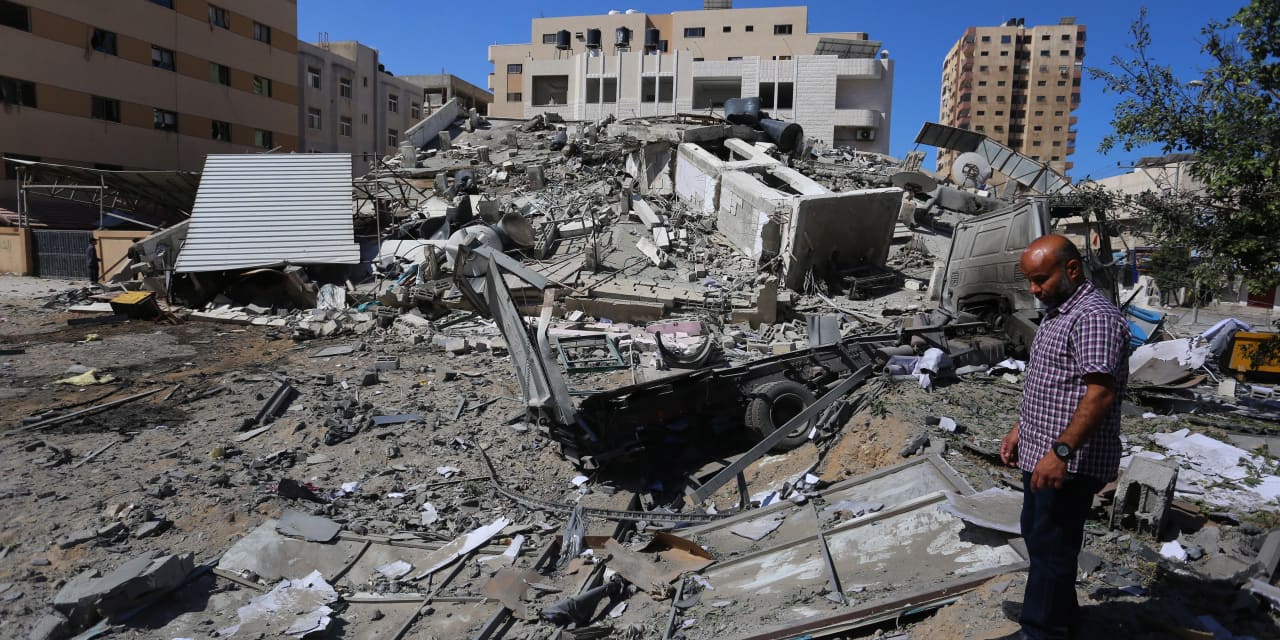
In conclusion, the Israel founding palestinian conflict is a multifaceted struggle with no easy solutions. From the historical roots to the ongoing tensions, this conflict has left an indelible mark on the region. While the path to peace remains challenging, understanding the complexities of the conflict, the perspectives of all involved, and the crucial role of international actors is a vital first step toward a possible future resolution.
Question & Answer Hub
What were the key events leading up to the 1948 Arab-Israeli War?
The Balfour Declaration, the rise of Zionist movements, and increasing tensions between Jewish and Arab communities in Palestine were major factors.
What are some common misconceptions about the conflict?
One misconception is that the conflict is solely about religious differences. While religion plays a role, it’s a much more complex issue involving land ownership, historical claims, and political motivations.
How has the conflict affected the region economically?
The conflict has severely hampered economic development in the region, causing instability, displacement, and a lack of investment.
What role has the United Nations played in the conflict?
The UN has played a complex role, attempting to mediate and create resolutions but facing significant challenges in achieving lasting peace.

